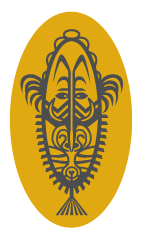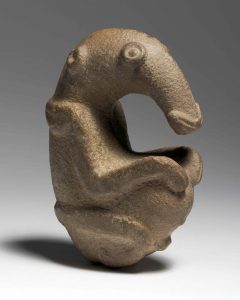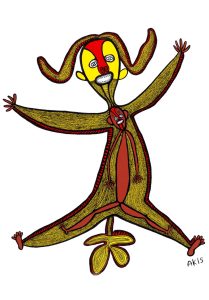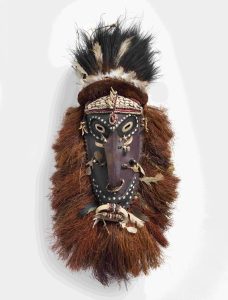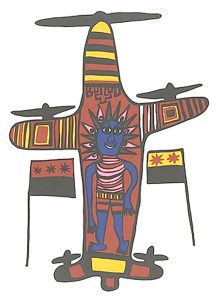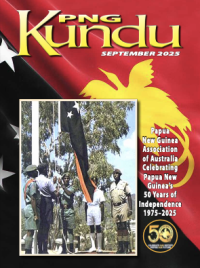Bilong Papua New Guinea at the National Gallery of Australia
Bilong Papua New Guinea: 50 years of Independence is an exhibition at the National Gallery of Australia, Canberra, opening 12 September 2025. The exhibition brings together a selection of the Gallery’s remarkable collection of Papua New Guinean art to mark the 50th anniversary of Papua New Guinea’s independence and the birth of the new nation on 16 September 1975.
Over eighty works from the Pacific Arts collection present stories, historical moments, and elements of custom and modernity in the leadup to the formation of the nation of Papua New Guinea and its development over the last 50 years. Together, the works display multiple facets of the art of Papua New Guinea, although as any members of the PNGAA will understand, in a country of over 800 distinct communities and more than 20 provinces, it is impossible to be fully representative in one exhibition. In the words of the first Prime Minister, Michael Somare:
One of the most important and difficult tasks facing any new country is the creation of a national identity. In order to weld together the multiplicity of cultures and languages that make up Papua New Guinea, we must first of all know what our complex cultural heritage is.
As a starting point for the exhibition, the great antiquity of Papuan cultures is represented by the Ambum Stone, a small sculpture known to many by its inclusion on Papua New Guinea’s 1970 5-cent stamp.
The Ambum stone is at least 3,500 years old and possibly around 10,000 years old. It was created by an unknown culture active in the Ambum Valley, Enga Province, whose identity is now unknown.
The form of the Ambum stone suggests a puggle, a baby echidna. During a visit to the National Gallery in March this year Prime Minister James Marape viewed the Ambum stone and noted how this highly refined sculpture created by his Papuan ancestors rivalled the arts of the contemporary era of Mesopotamia, considered the ‘cradle of civilisation’.
Two important artists in the exhibition, Timothy Akis and Mathias Kauage, are connected within the story of Papua New Guinea’s modern art history. Akis began his artistic career drawing for anthropologists researching in the Highlands. In the late 1960s Akis visited Port Moresby and encountered Georgina and Ulli Beier, an English-German couple working for the University of Papua New Guinea. The Beiers were a catalyst for contemporary arts in Papua New Guinea, encouraging, supporting and championing New Guinean artists as the country moved towards independence.
Akis, a Maring man, enjoyed drawing insects, lizards, cassowaries, birds, spirit beings and people, all informed by his life in the Simbai Valley. He was the first New Guinean artist to hold a solo exhibition. This exhibition is recognised as a milestone in contemporary Papua New Guinean creative practice and Akis’ contribution to the arts was considerable. In 2024 the annual Akis Art Prize was inaugurated in Port Moresby by the Arts Society of Papua New Guinea to recognise and celebrate artists active today. A group of prints and drawings by Akis are a feature of the exhibition.
That first exhibition by Akis proved pivotal in many ways. Mathias Kauage, then working as a cleaner at the University, attended the opening and the exhibition introduced him to art. From this fortuitous encounter Kauage, from Simbu Province, became the most internationally recognised artist from Papua New Guinea and worked in printmaking, drawing, painting, textile appliqué, and copper-beating over a long career beginning in the 1970s. He found inspiration in the urban changes occurring around Port Moresby at that time, the growing number of cars, motorbikes, and helicopters, and changes in social attitudes.
One of Kauage’s works in the exhibition is ‘Independence Plane, 1977’, his depiction of the royal aircraft which brought His Majesty King Charles III (then the 27-year-old Prince of Wales) to Papua New Guinea for the Independence Day celebrations. His Royal Highness delivered a speech in tok pisin as part of the raising of the new national flag ceremonies at Sir Hubert Murray Stadium in September 1975. Within the body of the aircraft shown in Independence Plane is a warmly humorous portrait of the young prince in his summer clothes, wearing a highlander headdress. In 1996 Kauage attended the opening of the Gallery of Modern Art in Glasgow, Scotland, and met Queen Elizabeth II. After the meeting Kauage created a painting for the Queen, and in 1998 received an OBE for his services to the arts.
The 1970s and the 1980s were marked by a surge in artistic creativity with artists imaging a new national identity through their work. The country presented an intriguing fusion of urban modernity and rural tribalism. Port Moresby developed with the construction of office blocks, shopping malls and skyscraper hotels, which co-existed with traditional social practices.
Beyond the regional centres it was, and remains, a nation of smaller communities with customary laws and local agriculture where people can live on smaller incomes than in the cities. Neither environment is mutually exclusive, with urban New Guineans often keeping ties to their ancestral villages and continuing the oral histories and stories of their communities.
In John Danger’s work ‘Untitled [man and woman] 2000’, this theme of connection is shown through two people split down the middle wearing the fashions, clothes and styles of both the village and the town. Danger has captured the unique nature of the evolving social landscape for many New Guineans.
The renowned traditional cultural arts of Papua New Guinea are also represented in the exhibition with carved sculptures, intricately woven bilum bags, decorated bark cloth, pottery vessels, shields and other works from the Sepik River, Oro Province, New Britain and New Ireland. A standout among these is the Brag Mask, c.1975, from the coastal Sepik region that still retains most of its decorations of fibre, cassowary feathers, dogs’ teeth and boar tusks. Brag spirits can be ancestral in nature or beings from the sea or the bush, and each is an individual with a name, personality, and community history. Brag masks when worn are brightly decorated and their appearance and performance at important community occasions are dramatic spectacles. The National Gallery’s Brag Mask has a historic connection as it appeared in performances during Independence Day festivities at a village along the coast of Broken Water Bay on 16 September 1975.
With art spanning prehistory to the Independence era, and more recent works, Bilong Papua New Guinea is a timely opportunity to see an impressive selection from over 2,700+ works of Papua New Guinean art in the collection of the National Gallery of Australia. The curators, Crispin Howarth and Dan Toua hope visitors will encounter, enjoy, and learn about Papuan New Guinea’s rich history and culture through the works on display.
An associated event, the Oceanic Art Society’s XII Forum, will be held at the National Gallery of Australia on 14–15 November 2025. This is a free series of talks and tours related to the art, culture, and history of Papua New Guinea.
All PNGAA members are welcome. Please see the OAS website for details: www.oceanicartsociety.org.au
CRISPIN HOWARTH
Curator, Pacific Arts
crispin.howarth@nga.gov.au
